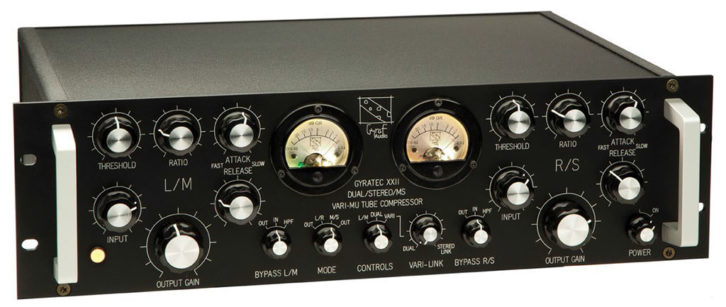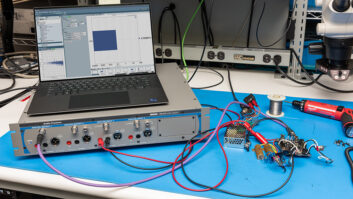Manufactured in Denmark, the Gyraf Audio (pronounced “giraffe”) Gyratec XXII, or G22, is an enhanced version of the company’s popular G10 stereo Vari-Mu tube compressor that preserves the all-tube, transformer and passive-component audio path. These are bespoke processors originally conceived and calibrated to the specifications of recording and mastering engineers. Today, all production models are built to order.

In a 3U cabinet, the G22 has two completely separate single-channel compressors with their own controls, modern op amp–based detectors, time-constant generators and sidechain systems. The G22 will process two individual mono sources, stereo signals in conventional L/R stereo, or stereo in Mid/Side mode using its built-in M/S matrix/de-matrix passive circuitry.
UNIQUE FEED-FORWARD DESIGN
The G22 has a variable-mu, feed-forward topology with updated control methodology that broadens its utility for creative recording, mixing and mastering work. With careful design, feed-forward compressors offer precision control over attack and release timing with super-fast attack times possible. The G22 has a wide range of adjustable compression ratios anywhere from 1:1 to infinity to 1, and is capable of very soft compression knees for transparent dynamic range control.
Feed-forward compressor topologies are typically found in modern VCA-based compressors, but examples of tube-based variable-Mu feed-forward compressors are rare. The vintage Telefunken U73b and U83 date back to the 1940s and are tube-based, feed-forward compressors used for transmitter over-modulation protection, and later on as disc cutting limiters.
Framed by two stout carrying handles, the G22’s front panel is nicely laid out with engraved names under the control knobs and rotary switches. There are two identical sets of compressor controls for the left and right channels. They are: Threshold, Ratio, Attack time, Release time, Input (level) and Output Gain.
There are independent, 6dB/octave 85Hz highpass, side-chain filters for both channels located as the third position on rotary Bypass switches for the Left and Right compressors. The Mode rotary switch changes the G22 from conventional L/R stereo operation to Mid/Side processing. For convenience, this switch also has two bypass positions located at the extreme left and right positions. So in addition to being able to bypass the two channels separately, the Mode switch will act as a global bypass for both channels.
When switched into M/S mode, the left channel (called L/M) becomes the Mid signal compressor and the right channel (called R/S) is for the Side signal. All the pots have detents and are made by Alpha, while the rotary switches are by French company APEM.
Apart from the Attack controls’ “Fast” (fully CCW) and “Slow” (fully CW) extremes, there are no approximate markings or values for the other controls. I thought there should be some nomenclature or more hash marks for recalling settings. The controls’ detents helped me count clicks nearest a hash mark.
CONTROLS SWITCH
The Controls rotary switch allows for three different schemes for the front panel controls. The first position at L/M “gangs” or slaves all the right channel’s controls, including the Input and Output level, and all rotary switch positions to the left channel’s controls. This would be for fast setups for stereo operation when using the G22 as two mono compressors. Under L/M Controls, all right channel controls are switched out and routed to duplicates stacked on the back of the left channel’s controls.
This feature is magical for keeping processor levels always locked together, and I found the two compressors to track very accurately when under L/M Control. However, this precludes changing any of the right channel controls, such as its output level, if you are not using an external console.
Next in Controls is the Dual position for two completely independent mono compressors. Dual is for conventional stereo or two mono audio tracks—there is no interaction at all.
Switching to the third position, Vari-Link, enables a variable stereo link that controls the amount of sidechain cross-linkage between the two compressors. It varies from no link whatsoever at fully CCW to 100 percent linked at full CW. This function should be its own control and not part of the Controls switching.
Early on, I learned that if you want to link for stereo operation in Dual, first go to Vari-Link and then start developing your settings. Switching into Vari-Link after you have arrived at your compressor settings will necessitate rejiggering everything. In general, I either didn’t use it all or I would start with it no more than at the halfway position. Vari-Link also functions in M/S mode,
Finishing off the front panel, there are two small, lighted Wenzhou Songtai VU meters to read gain reduction only. I liked the VU’s instant, “at-a-glance” visual status of the G22. In hardwire bypass both VU meters dim and fully light up in operation. The right channel dims when in L/M Control and in M/S mode, the (left channel’s) Mid meter adds a red LED and the (right channel’s) Side meter adds a green LED.
INSIDE THE G22
A look inside reveals a main circuit board that occupies about one-third of the width of the internal space. This much leftover internal volume negates the need for vent holes, external heat sinks or any ventilation at all. In continuous use, I found the unit only gets slightly warm on the top cover’s rear quadrant, which bodes well for installing the unit into a tight rack without worry. Besides the main board with its solid-state power supply and voltage regulator circuitry, there is also a large toroidal power transformer mounted at some distance on the other side of the cabinet.

All the front panel pots and rotary switches are mounted on printed circuit subassembly boards with ribbon cables inter-connecting them and also back to the main board. The main circuit board has a pair of Lundahl LL1540 transformers for the 10K bridging inputs and M/S matrix; another pair of big Lundahl LL5402 transformers handle the outputs and the M/S de-matrix.
There are two tubes per channel, or four total. Each channel uses all Class-A double-balanced topology with a PCC-189 (7ES8) remote cutoff dual triode differentially driving an ECC-88 (6DJ8) dual-triode output stage.
The side-chain/control section uses TL074L quad op-amp chips for deriving threshold, attack and release timing, compression ratio, Vari-Link and the HPF. All audio passes through only the transformers, tubes and passive components. Changing from L/R to M/S mode, bypass and the L/M, Dual and Vari-Link Controls are all switched using subminiature relays. To be expected, if audio is passing through the unit, there is a small click heard when toggling between L/R and M/S modes.
THE G22 IN PLAY
With the G22 patched as an insert into a Master fader on a stereo mix in Pro Tools, I calibrated both the left and right channels using an -18dBFS 1kHz tone at unity gain in/out. There is no way to read output level on the G22’s VU meters, so I relied on a metering plug-in in Pro Tools.
I matched both channels’ controls: Threshold at full CW (off), Ratio full CCW (1:1 or off), Attack and Release controls at the middle of their ranges, and the HPF not used. I would begin with the Output at 1 pm and the Input control around 1pm for unity throughput but these two controls are subject to big changes later, when I would go back and re-check stereo balance.
I first tried the G22 as two separate compressors in Dual mode on a stereo mix. The nice feel of the pots made it easy to adjust the L/R Input controls to give me unity with no audible level or sound change when switching the unit in and out of circuit using the Bypass switches.
For a 1950s-style design, I found the left and right channels to “track” very well after full warmup time—within 0.5 dB or less. Mastering engineers will like the G22’s resettable and reliable consistency.
Getting the desired amount of compression with this style of compressor/limiter is always a balance between the Input level and the Threshold level, but now there is also the variable Ratio control to consider. Fully adjustable ratio adds a strong overall control, with higher settings easily clamping peaky programs such as dialog or percussion recordings.
For a dialog track I was editing, the G22 worked like a transparent peak limiter with instantaneous gain reductions hitting up to -20dB on the meter! Ratio was high—at around 2 pm and Release was at its fastest. The Attack control at around 10 am (fast) easily sets the dialog’s brightness and peak level. Faster attack times will tend to dull the sound, and I liked that this effect is completely adjustable on the G22.
Once both channels were calibrated, I could switch over to L/M Controls to further fine-tune gain reduction and not worry that the stereo balance might go off when manually trying to adjust two sets of controls accurately.
The G22 has plenty of input gain range available for the wackiest settings, but this is a very soft curve compressor and it is hard to get into much trouble here! Even with massive (indicated) gain reductions, the sound never distorted or sounded excessively squashed—even with the fastest release time possible at 50 ms, the overall sound only slightly dirtied. I’m impressed!
M/S PROCESSING
I successfully widened a stereo mix using the M/S function of the G22. While the L/M Controls mode worked great for balanced processing of conventional stereo, the Dual Controls mode worked best for M/S.
As above, I would start in Dual Controls calibrating and matching L/R throughput levels. Once satisfied in conventional stereo, I switched into M/S mode. By separately monitoring the Mid and Side signals in mono, I adjusted that channel’s compressor controls. To (temporarily) monitor the Side signal properly, I flipped the polarity of the Side signal on my Avocet II monitor controller.
I would mark on the front panel (with a small bit of tape) the current Output level control settings. With no way to solo or mute the Mid or Side signals independently, I would turn either of their Output knobs down to zero.
I would re-balance the levels of the Mid and Side signals and, depending on how much uncorrelated audio you have going, this can be an awesome tool to widen or narrow a mix. Generally, I liked compressing the Side signal slightly more, but this is totally dependent on the music content, as it should be. For a mix effect, I would increase the Side signal only on choruses.
If you’re looking for aggressive sound, it is easy to overdrive the G22, and I liked what it did to a boring synth bass track. By trading input level coming in, threshold setting, ratio and using a fairly slow attack time settings, I got an edgy bass attack and a thick, colorful sustain that my bass player loved.
I like using the G22 in Dual mode for a lead vocal and double-track. After I got the settings for the lead vocal playing through the left channel, it was easy to switch over to L/M Controls mode to duplicate the settings for the double-track playing through the right channel. I lowered the level of the double back on the mixer and I was done!
PRETTY IMPRESSIVE GYRAF!
The Gyraf Audio Gyratec G22 Stereo/Dual/MS Compressor turns out to be not only a good mastering processor but also a fascinating processor to have in the recording studio. I like its unique sound for processing stereo mixes or individual instrument and vocal tracks. The L/M mode allows fast setups for vocals, to go with its transparent and uncolored sound for live recordings and its pristine compression, makes it a winner!
PRODUCT SUMMARY
COMPANY: Gyraf Audio
PRODUCT: Gyratec G22 Stereo/Dual/MS Vari-Mu Compressor
WEB: http://gyraf.dk/product/g22/
PRICE: $4450
PROS: The learning curve is well worth the results
CONS: A little confusing controls layout and duplicated functionality







